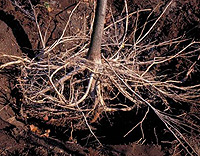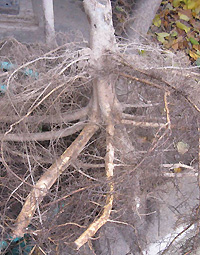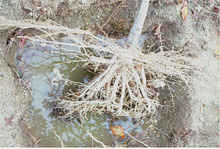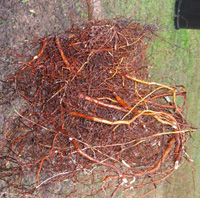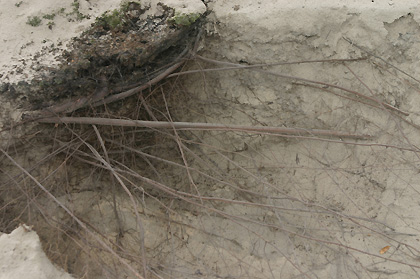Home > Root growth > Roots in nature vs. nursery > Root growth comparisons after planting
Root growth comparisons after planting
Objective of tree establishment is to encourage rapid root growth into landscape soil. Root growth occurs about equally well from bare root, container, or field grown nursery stock under the best of conditions. This allows the tree to remain vigorous so it quickly establishes. Another component of tree establishment is root system structure. Root system structure can have a large impact on tree stability and tree health. Therefore it is important to understand what makes for a structurally strong root system. Root growth from container and field grown nursery stock: Roots in field grown root balls can be oriented primarily down as shown in Figure 1 (top), or they can be oriented horizontally and down as shown in Figure 1 (bottom). This large difference in orientation can impact how roots grow into landscape soil. |
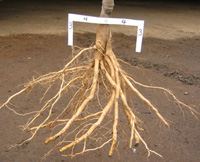 |
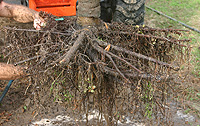 |
|
Figure 1. Field grown root balls. Top shows roots oriented down, bottom shows many horizontally oriented surface roots. (Top photo courtesy Keith Warren.)
|
|
Figure 2. The new roots that grow from the cut root ends that are deep (e.g. 12") in the soil often grow up toward the surface. Only a few adventitious roots developed on this tree after it was planted into the landscape. |
New roots grow from the tree shown in the top of Figure 1 in two manners. Roots can either generate from the cut ends (Figure 2), or roots can grow adventitiously from the base of the trunk or base of the main roots (Figure 3). Some trees do both (Figure 4). Some roots growing from the cut ends grow up toward the soil surface because there is more oxygen in the shallow soil layers in many urban sites. This can result in a root system that looks something like that shown in Figure 5. Roots grow from the tree shown at bottom of Figure 1 as shown in Figure 6. |
Figure 3. Adventitious roots growing from the tree just under the soil surface after planting. The original adventitious root flare is clearly visible as the 7 or 8 larger roots about 8 inches deeper into soil profile. |
Figure 4. Short new roots grew after planting into the landscape from existing deeper nursery roots, and adventitious roots emerged close to the soil surface and grew radially more or less straight from the root flare.
|
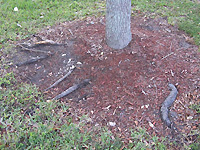 Figure 5. Roots grew up toward the surface from downward oriented roots that were cut when the tree was dug in the nursery. We think this results from lower oxygen content deeper in the soil profile discouraging root growth there. This tree also seems to have been planted too deeply into the landscape. Deep planting also can cause this root form. |
|
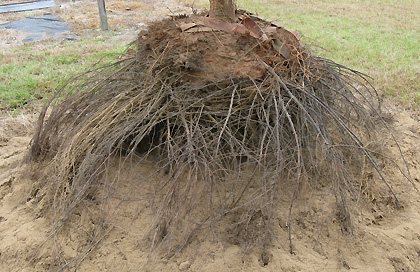 Figure 6. Roots grew out into landscape soil more or less radially straight from horizontal oriented roots in the root ball. This is a desirable root sytsem. |
|
The largest diameter roots on some container grown trees end up near the bottom of the container (right). This results in many roots growing out the bottom of the container (below).
|
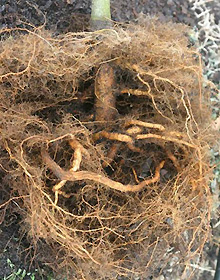 |
| Roots that circled in the container remain in that position for ever. New roots grow from existing root tips inside the root ball and from roots that circle or grew down the sides of the container wall. | |
Figure 7. New roots grew out into soil two years after planting.Roots that circled the outside periphery of the root ball while tree was in the container remain in that position forever. |
|
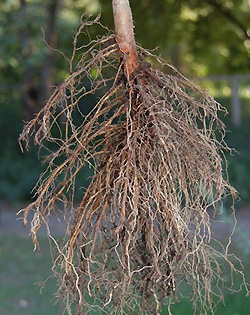 There may be merit to producing trees with this root system form whether grown in a container or in the field. A root ball with this configuration would position roots more or less evenly along the sides of the root ball. This is likely to encourage root system symmetry. This might also help roots become established in landscape soil; deep roots could develop if landscape soil conditions allowed and shallow roots could develop easily in compacted soils. |
|

